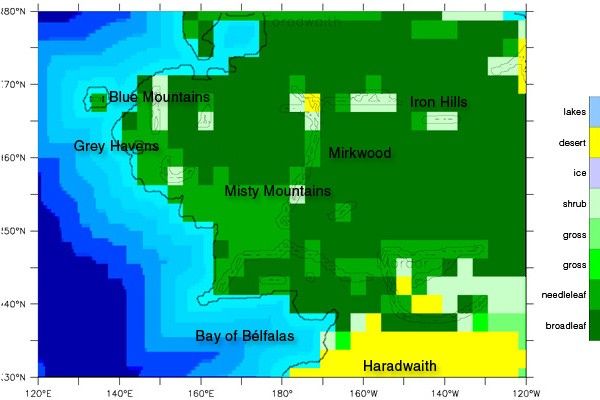
Dan
Lunt is a climate scientist at Bristol University in Bristol, UK. He
created a computer model of the climate of Middle-earth from J.R.R.
Tolkien’s
The Lord of the Rings. Writing under the name
Radagast the Brown, Dr. Lunt published an article about it. In order to
make the article accessible readers in Middle-earth who don’t know
English, he published it
Elflish and
Dwarfish as well as
English.
Science magazine reports:
Using
supercomputers and a model originally developed by the U.K. Met Office,
his study compares Middle-earth’s climate with those of our (modern)
and the dinosaur’s (Late Cretaceous) worlds. The Middle-earth model
(pictured, showing predicted ground coverage: with grass in light green,
trees in darker green, desert in yellow, and ice in white) reveals that
the Shire—home to the Hobbits—would enjoy weather much like England’s
East Midlands, with an average temperature of 7°C and about 61 cm of
rainfall each year. An epic journey to Mount Doom, however, would see a
shift in climate, with the subtropical Mordor region being more like Los
Angeles or western Texas. The study—released today on the University of
Bristol’s website and available in English, Elvish, and Dwarvish—also
shows that the elves probably sailed from the Grey Havens because of
that region’s prevailing easterly winds, while the dry climate east of
the Misty Mountains is formed by a rain shadow.
It’s a
fun idea for publishing and a sure way to get public attention. But
Radagast’s work is also a serious attempt at understanding climate
modeling. A
press release from Bristol University explained:
Among
other findings, he explains why the elves set sail from the Grey Havens
(the prevailing winds were favourable for their journey to the West),
and the existence of a dry climate east of the Misty Mountains (the
mountains cast a rain-shadow over the region). Radagast also discusses
the strengths and weaknesses of contemporary climate models, and shows
how they can be used to understand and predict future climate. […]
Dr
Dan Lunt added: “This work is a bit of fun, but it does have a serious
side. A core part of our work here in Bristol involves using
state-of-the-art climate models to simulate and understand the past
climate of our Earth. By comparing our results to evidence of past
climate change, for example from tree rings, ice cores, and ancient
fossils of plants and animals, we can validate the climate models, and
gain confidence in the accuracy of their predictions of future climate.”
 Dan
Lunt is a climate scientist at Bristol University in Bristol, UK. He
created a computer model of the climate of Middle-earth from J.R.R.
Tolkien’s The Lord of the Rings. Writing under the name
Radagast the Brown, Dr. Lunt published an article about it. In order to
make the article accessible readers in Middle-earth who don’t know
English, he published it Elflish and Dwarfish as well as English. Science magazine reports:
Dan
Lunt is a climate scientist at Bristol University in Bristol, UK. He
created a computer model of the climate of Middle-earth from J.R.R.
Tolkien’s The Lord of the Rings. Writing under the name
Radagast the Brown, Dr. Lunt published an article about it. In order to
make the article accessible readers in Middle-earth who don’t know
English, he published it Elflish and Dwarfish as well as English. Science magazine reports:
No comments:
Post a Comment